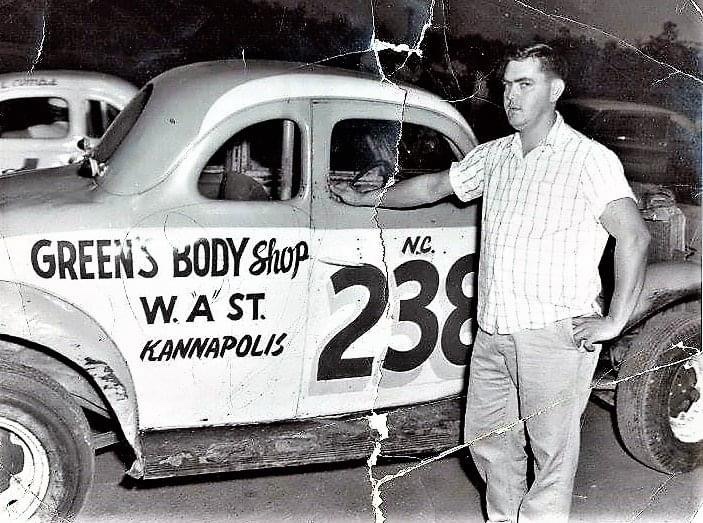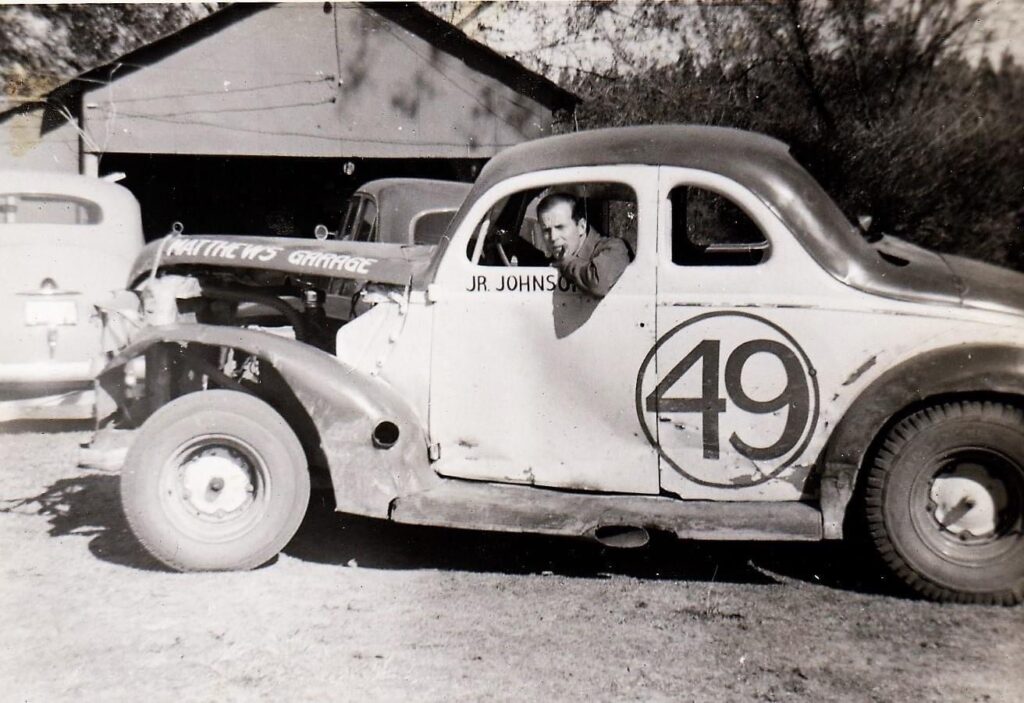Julius David Johnson, Jr. – Written by Dargan Watts
OCALA, Fla. – Julius David Johnson and Robert Glenn Johnson probably never met, but the two men did have some things in common. Julius and his wife, Goldie, had twin sons and one of them was named Julius David Johnson, Jr. They had two other sons, one older than the twins and one younger. Robert Glenn and his wife Lara Belle had seven children and one of the sons was named Robert Glenn Johnson, Jr.
Robert Glenn Johnson, Jr. was born in Ingle Hollow, N.C. and Julius David Johnson, Jr. was born in Horry County, S. C. Both juniors became race car drivers, and both were very good at it. The Junior Johnson from North Carolina started his career in 1953 as a former convicted moonshiner and recorded 50 Grand National wins over a 14-year career. After retiring as a driver, he became a fulltime car owner, recorded 119 and won six national titles. Cale Yarborough won three and Darrell Waltrip won three.
Both juniors had sons who raced, but Julius David had a younger brother (Cecil) who was a terrific driver as well. His twin brother, Leo, was at most of racing events and his older brother, Carl, attended the races on occasion. The South Carolina Johnson farmed with his dad and brothers until they moved to the Ebenezer Community in Florence County around 1954, and that’s when J. D., as we will refer to him, got the racing bug shortly thereafter. He, with help from a friend, Clarence Matthews, started racing at Myrtle Beach, Columbia, Sumter, Charleston, Cooper River and Ashwood. He also ventured into North Carolina, gaining experience and building a reputation as an excellent car builder and driver. It didn’t take long for the word to get around about how good he was as a builder, so he started building cars for other teams as well. He ran in the Limited Sportsman as well as the modified divisions of NASCAR.
I got to know both Junior Johnsons, but the Florence South Carolina Junior and I worked together more, so I got to know the family more. I was privileged to be around Junior and his brother Cecil as drivers and car owners and Juniors twin, Leo was at most of the racing events. Then, along came Slick or legally known as Julius David Johnson III. Junior was a person who met no strangers and if someone he had never met would walk up and start a conversation, it wouldn’t be long before one would think they had known one another all their lives. He was friends with all of the drivers, car owners and helpers. He was in the racing business to make a living, but if another team was in trouble mechanically, he was the first one to try to help. If a team had a handling problem, the door to the Johnson shop was always open and his frame machine was kept in use nearly full time working on race cars owned by others.
He had an open door for all of the competitors who were at Darlington Raceway. His machine shop was right there for all to use and many cars that met with famed Darlington wall were repaired at the Johnson shop.
Back in the 60’s Junior was at Sumter Speedway, while Jimmy Hatchell was at another track with a second car and Slick was in a third car at another track. It started raining before the program at Sumter got underway, and at the time, I was doing a feature story on a particular driver every week, so I felt that was the perfect time to get Junior in my car and ask him some questions about his life as a fulltime racer. He cautioned me that if it continued to rain, he would leave me in favor of heading 100 miles north to Dillon Speedway where it was powder dry. I assured him it was going to stop raining in Sumter and we would get the race in, but he kept his hand on the door handle and let me know several times that he had to move on to Dillon.
Finally, the rain ceased to fall, and Junior unloaded his car, qualified for the race and finished first.
In the early 60’s, NASCAR started the Late Model Sportsman division, and all the area independent tracks followed suit, racing later model cars that were manufactured at least four years prior. Many of the independent tracks were offering purses that were higher than those that were NASCAR sanctioned, mainly because there was no point fund nor sanctioning fee. For several years, NASCAR would revoke the license of any driver caught competing on any independent facility, so teams had to decide one way or the other.
By the mid-60’s NASCAR was challenged, and it was decided that the drivers and car owners were independent contractors and the sanctioning body could not impede a person from making a living, so it was a new ballgame. For J D (Junior) and his brother, Cecil, who actually ran his own team, could race when and where they wanted. Cecil was still a fulltime farmer and only raced when the farm work was done. Junior brought a young man by the name of Jimmy Hatchell on board as a driver of one of the sister cars and this gave the Junior Johnson Racing team a double and sometimes a triple whammy on the field. Starting on Thursday, it was Columbia Speedway, Friday, it was Hartsville and on Saturday, it was where the most money was. The Johnson group would roll into a track expecting to take home first place money, so in order to do that, each driver would go in a different direction on Saturday and more often than not, Junior and Hatchell would each bring home the top prize money. Then, on Sunday, it was a Charleston area track, and sometimes into North Carolina where the blue laws were not against Sunday racing.
Junior probably could have made a good living if he had decided to join the Grand National Tour with NASCAR, or even the National Late Model Sportsman circuit, but he was satisfied to be his own boss and was not a lover of motel rooms. He felt he would have to go out and try to recruit sponsors to help with the expenses to run several nights a week across the country and if he had sponsors, he would be told when and where he had to race, so the reason he seldom had any advertising on any of his cars, is because he just simply didn’t want to be obligated to anyone.
After driving for Matthews, Johnson went on his own and built his first car in a shop located in his back yard. His young son, J D III, also known as “Slick” was his helper in the shop and in 1962, at the ripe old age of 14, Slick built his first race engine. A couple of years later, the 16-year-old became a driver after his parents signed the proper paper work, allowing him to do so. Now Junior had his car, Slick in a “learner” and his brother, Cecil, who raced only when the crops didn’t need his attention.
In the meantime, Junior’s wife, Virginia, was raising two daughters, Joyce and Judy plus working fulltime as a department manager at Sears. Slick later became a fulltime partner with his father in the shop and headed up the machine shop along with racing three to four nights a week.

Junior not only built his cars from top to bottom, he was becoming more of a name in the state of South Carolina than the other “Junior” in North Carolina. All three of his cars and drivers were racing as often as possible and chalking up wins and track championships all over the Carolinas and Georgia. Other than Junior and Slick in the shop and Hatchell handling the driving chores on one of the cars, the Johnsons depended on other family members and friends to help. Chippy Johnson helped in the machine shop and traveled with one of the cars as well as raced one of the cars while John Hare was there to help in various ways, but mainly handled the framework and kept the cars sleek and professional looking. Of course, the icon of the Johnson team from 1961 until 1995 was Allen Cooper who always wore a Caterpillar baseball cap that had across the front in big letters, “CAT”. I knew “Cat” for 50 years before I knew he had any other name.
Johnson, was approached by many track promoters who wanted to “rent” one of his cars for a marquee driver to challenge the regulars on a given night, and Junior would accommodate them for a set sum of money. That list of drivers is a “Who’s Who” in racing, Including Dale Earnhardt, Cale Yarborough, Lee Roy Yarborough, Morgan Shepherd, Sam Ard and Darel Dieringer, to name a few.
Even with “renting” his car to various tracks, Johnson himself recorded 511 wins and 17 track titles. I was unable to gather the records for Hatchell but I know it was more than eight track titles. The records are incomplete for Slick, but Tim Bryant took over the #1 usually driven by Junior and won three track titles in one year.
Slick entered the Cup series in 1979 and ran two races for independent owners and two more races in a car owned, financed and built by the Johnson family. He finished 13th and 10th in the family owned car. In 1980, the young driver competed in 18 races and was in the top 10 on five occasions. He finished fourth in the Rookie of The Year balloting and was the top finishing true independent. He ran a limited Cup schedule through 1987. He competed in one ARCA event in 1989 and finished 10th. The following year, disaster struck the Johnson family as Slick was involved in a wreck in the ARCA race at Daytona. His injuries were so severe that he died two days later, nine days before his 42nd birthday.
Junior lost interest in auto racing and turned to building and maintaining Go-Karts for two of his grandsons. He was just as good at building the Go-Karts as he was the powerful race cars. He was so well-thought-of at the Southern Kartway at Loris, S.C., a memorial race is held each year in his memory.
Johnson passed away in 2011.
HE WILL BE INDUCTED INTO THE AUGUSTA INTERNATIONAL RACEWAY PRESERVATION AUTHORITY (AIRPS) HALL OF FAME ON OCTOBER 21, 2022 ALONG WITH JACK PENNINGTON AND OTHERS.
Junior Johnson and the first race car he ever drove

